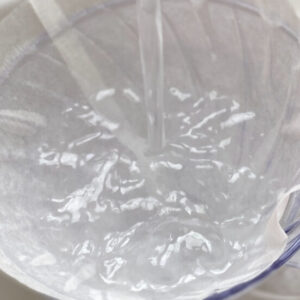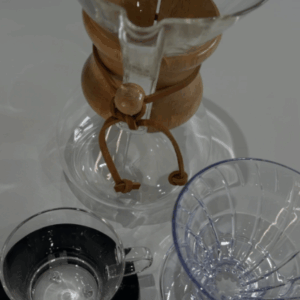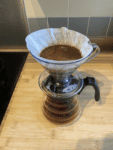Ultimate Guide to V60 Coffee
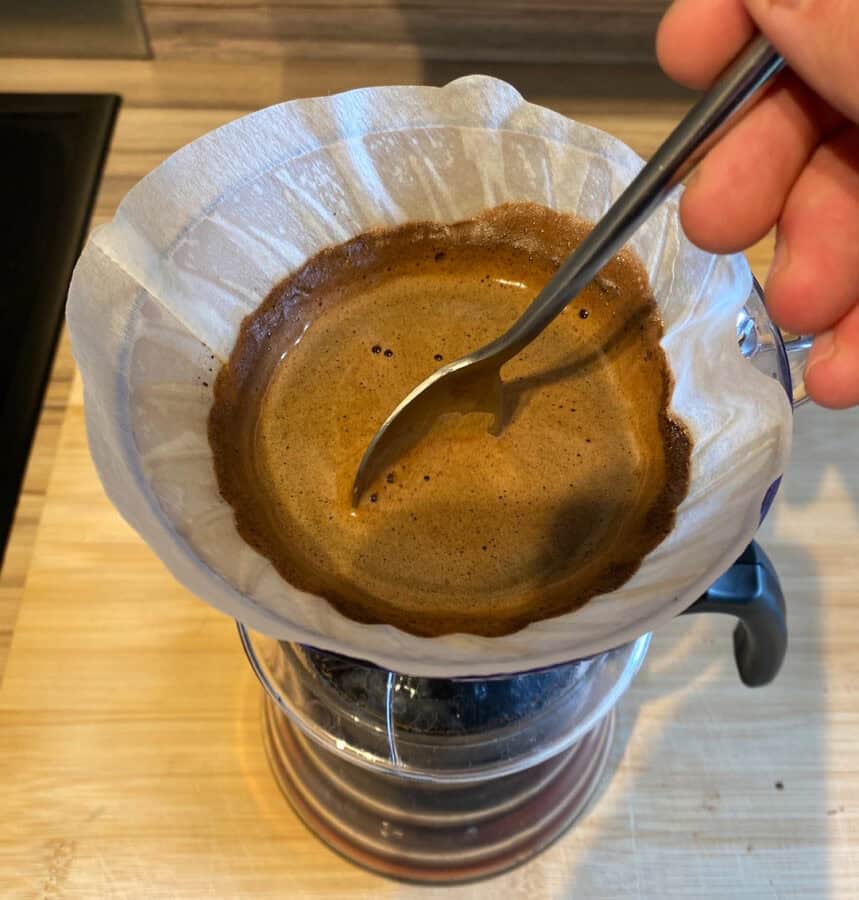 The V60 stands out as a beloved tool cherished by coffee lovers worldwide. It is such a simple yet effective coffee brewing tool that can make outstanding coffee with a clean, fresh and delicate flavour.
Where some more popular coffee brewing methods like espresso and the French Press offer bold, punchy and viscous coffee, a V60 brew is a far more delicate affair.
V60 coffee brewing can be a rewarding pursuit, as it offers silky smooth, fresh and refined coffee that cleans out your pallet and emphasises crisp tasting notes. However, V60 brewing is not without its challenges. Even seasoned enthusiasts can fall prey to common pitfalls of V60 brewing, leaving them with less than desirable results.
In this article, I will give you the ultimate guide to V60 coffee, including how to use one properly, which coffee beans work best for the V60, common V60 mistakes and more top tips.
The V60 stands out as a beloved tool cherished by coffee lovers worldwide. It is such a simple yet effective coffee brewing tool that can make outstanding coffee with a clean, fresh and delicate flavour.
Where some more popular coffee brewing methods like espresso and the French Press offer bold, punchy and viscous coffee, a V60 brew is a far more delicate affair.
V60 coffee brewing can be a rewarding pursuit, as it offers silky smooth, fresh and refined coffee that cleans out your pallet and emphasises crisp tasting notes. However, V60 brewing is not without its challenges. Even seasoned enthusiasts can fall prey to common pitfalls of V60 brewing, leaving them with less than desirable results.
In this article, I will give you the ultimate guide to V60 coffee, including how to use one properly, which coffee beans work best for the V60, common V60 mistakes and more top tips.
What is a V60?
The V60 is a manual pour-over coffee brewer designed by Hario, a renowned Japanese glassware company. Its name, “V60,” originates from its characteristic V-shaped cone and the 60-degree angle of its walls. This cone-shaped dripper can be crafted from various materials, including glass, ceramic, plastic, and metal, each offering distinct aesthetic appeal and heat-retention properties. The most popular V60 is the simple plastic coffee brewer, which is the easiest to clean and maintain. The classic plastic V60 is also the most cost effective and portable in the range, making it incredibly versatile.The Best Grind Size for V60

Too Coarse Leads to Under Extraction
As far as the V60 is concerned, aiming for a medium grind is the best way to go for people new to this brewing method. It is definitely better to opt for a grind you think may be too coarse when starting out, than one that’s too fine. This will give you weaker coffee, but more consistent results. From there it is easy to dial the grind size down to find your desired strength. However, if you grind your coffee too coarsely, (like you would for French press) you’ll end up with under extracted coffee. This means that the hot water has not come into contact with enough of the coffee’s surface area, and not enough of the flavour compounds and oils have been extracted from the coffee. This results in watery, weak and sometimes sour coffee that is quite unpleasant to drink.Too Fine Leads to Over Extraction
On the other end of the spectrum, using a fine grind more suited to espresso in your V60 will lead to over extraction. Over extraction is actually more common than you might think across many different coffee brewing methods, and causes the coffee oils to be extracted too quickly. This leads to bitter, burnt tasting coffee that can have a silty aftertaste and is also pretty nasty to drink. You’ll also most likely experience astringency, which is an unpleasant dry aftertaste at the back of your throat. Therefore, I would say it is definitely better to start off slightly too coarse and dial it down finer with each brew than the other way round. After all, you’d rather have coffee that’s slightly weaker than you might like, rather than a bitter and astringent brew!What to Consider When Choosing Coffee for Your V60
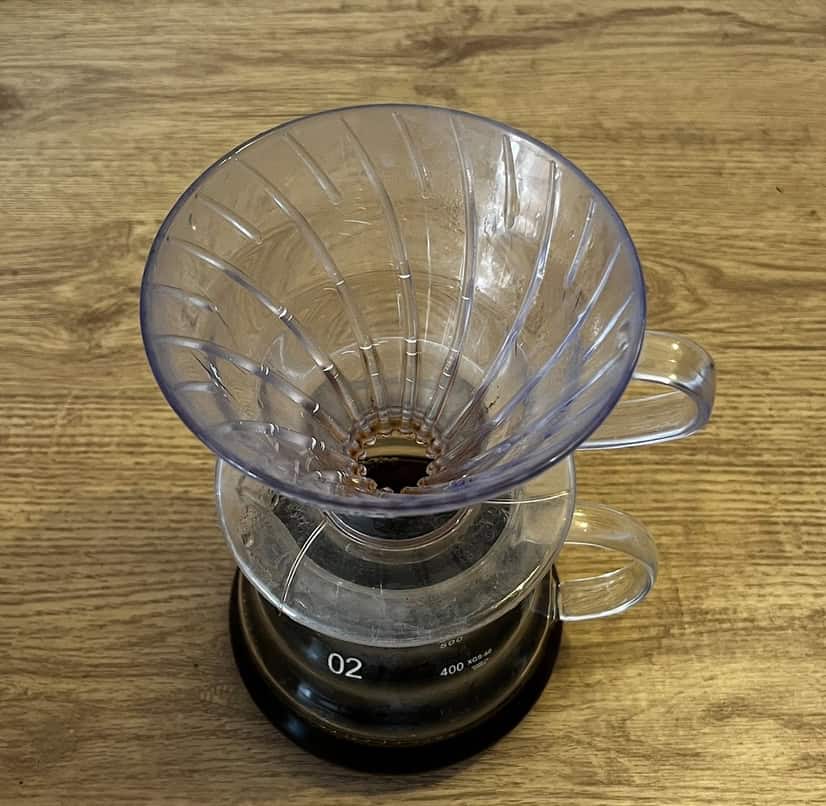 When selecting coffee beans for your V60, several factors come into play. As mentioned above, there isn’t necessarily a wrong answer when it comes to picking coffee beans for your V60.
However, there are a number of recommendations that I suggest you bear in mind.
When selecting coffee beans for your V60, several factors come into play. As mentioned above, there isn’t necessarily a wrong answer when it comes to picking coffee beans for your V60.
However, there are a number of recommendations that I suggest you bear in mind.
Roast Level
Consider the roast level that suits your taste preferences, ranging from light to dark. This is an often overlooked factor when it comes to picking coffee beans, especially for the V60. Whilst the device itself is simple and easy to use, this doesn’t mean it should be underestimated. V60 coffee brewing requires solid technique, and can be messed up easily if not done properly. With this in mind, choosing the perfect roast level for the coffee beans you’ll be using is very important. I mentioned earlier that you should steer clear of very dark roasted coffee beans when using a V60. This is just my recommendation, and I’m not saying there’s anything wrong with these coffee beans whatsoever. But, I do think that they are better suited to coffee brewing methods that tend to deliver a more full bodied cup, with a bolder flavour profile and higher TDS. Therefore, I would recommend opting for a medium or light roasted coffee bean when using a V60. This will help draw out the complexity and delicacy of flavours, giving you the most pure and delicious coffee experience possible.Origin
Different coffee-growing regions impart distinct flavours and characteristics to the beans. Again, whilst there is no right answer here, there are some origins (and more importantly flavour tasting notes) that lend themselves better to the V60 than others. Here are some of the best origins and bean varieties that I would suggest you try if you’re on the hunt for perfect pour over coffee beans for V60 brewing:- Kenyan AA
- Ethiopian Yirgacheffe
- Tanzanian Peaberry
- Sumatran Mandheling
- Ethiopian Sidamo
- Brazilian Santos.
Flavour Profile
It is important to pay attention to flavour notes such as fruity, chocolatey, or floral, which align with your preferences. Given the V60’s tendency to bring out clean, vibrant and crisp flavours, it would make sense to use coffee beans that compliment this. As mentioned, there’s nothing wrong with going for a dark roasted coffee with smoky or even burnt flavours if that’s what you are really into. However, I would argue that medium roasted coffee with flavours such as chocolate, nuts or caramel work well with a V60. If you prefer to go on the lighter side of things, then opting for fruity, floral or citrus flavours can also be extracted well with the V60.10 Common V60 Coffee Mistakes (And How to Avoid Them)
Here are 10 of the most common V60 coffee mistakes that even the most seasoned home baristas make, and how you can avoid falling victim to them!1. Using Stale Coffee Beans
Mistake: Using stale coffee beans will give you a flat, lifeless brew with muted flavours and aromas. Coffee beans take a long time to spoil, but they lose a lot of their aromatic flavour approximately 45 days after roasting. How to Avoid: Invest in freshly roasted coffee beans and grind them just before brewing to preserve their underlying flavours and aromatics. Using a good quality burr grinder will make this process a lot easier.2. Using the Wrong Grind Size
Mistake: Inconsistent grind size leads to uneven extraction, resulting in a brew that is either over-extracted or under-extracted. If you use a grind size that’s too coarse, you’ll end up with an under extracted cup of coffee, whereas a grind size that’s too fine will lead to over extracted. How to Avoid: Use a high-quality burr grinder to achieve a consistent grind size tailored to your V60. Aim for a medium grind size which is a similar consistency to fine table salt, more coarse than espresso but finer than French press.3. Water Temperature Too Hot
Mistake: Water that is too hot can scorch the coffee grounds, leaving you with a bitter and astringent tasting cup of coffee. On the other hand, water that is too cold may not extract enough flavour from the coffee grounds, so there is a fine balance to strike. How to Avoid: Aim for a water temperature between 195°F to 205°F (90°C to 96°C) for optimal extraction without compromising flavour. Darker roasts work best with slightly lower temperatures, whereas lighter roasts need temperatures on the higher end of this range. Make sure to wait 30-60 seconds after your kettle has boiled before pouring the water over the coffee grounds. Or even use an electric temperature controlled kettle if you want to be really precise.4. Neglecting the Bloom
Mistake: Skipping the blooming stage prevents the release of carbon dioxide, leading to uneven extraction and a bitter or even sour tasting brew. Blooming is an essential part of V60 coffee brewing, so don’t neglect it! How to Avoid: Prioritise the blooming stage by pouring a small amount of water over the coffee grounds and allowing them to bloom for 30 seconds before continuing with the brewing process. You should aim to pour over around 2-2.5 times the amount of water, compared to the weight of coffee used. So if you’re using 20g of coffee, aim to add 40-50g of water in the blooming phase.5. Poor Pouring Technique
Mistake: Pouring water too quickly or aggressively can cause agitation and uneven extraction in your V60 coffee bed. Whilst a bit of turbulence is a good thing to get the coffee grounds saturated with water, too much will lead to uneven extraction. How to Avoid: Master the art of a controlled pour by maintaining a steady, circular motion over your coffee bed. I would recommend starting off your pour in the centre, then slowly pouring in a circular motion, gradually working your way to the outside edges. This technique will ensure even saturation of the coffee grounds throughout the brewing process, and a more balanced brew.6. Over Pouring Water During Blooming
Mistake: Over pouring water floods the coffee bed during the blooming phase will lead to over saturating the coffee grounds. This in turn creates uneven extraction and can lead to channelling. How to Avoid: Aim to pour your water in a slow and controlled way, making sure not to allow too much hot water out of the kettle’s spout all at once. Make sure not to exceed the capacity of the V60 dripper, as an overflowing V60 will cause a big mess!7. Ignoring the Coffee-to-Water Ratio
Mistake: Neglecting to adhere to the proper coffee-to-water ratio can result in a brew that is either too weak or too strong. I would recommend aiming for a 1:15 coffee to water ratio for V60 coffee brewing. How to Avoid: Use a digital scale to measure your coffee and water accurately, aiming for a ratio of 1:15 (coffee to water) for a balanced cup.8. Neglecting Stirring or Agitation
Mistake: Failing to stir or agitate the coffee slurry can lead to uneven extraction and a lack of clarity in the final brew. You want just enough agitation to ensure all of the coffee grounds receive an even amount of hot water to extract those coffee oils. How to Avoid: Stir the coffee slurry gently after each pour to ensure even saturation and promote consistent extraction. Then, once you’ve added the desired amount of water, allow the coffee slurry to rest and let them run dry.9. Using Plain Tap Water
Mistake: Tap water may contain impurities or chlorine that can impart off-flavours to your coffee. The amount of limescale in your water will also vary depending on where you are in the world, so using a water filter will ensure consistent results with V60 brewing. How to Avoid: Use filtered or bottled water to brew V60 coffee. This will ensure you have consistent, pure and delicious tasting results time after time.10. Not Making a Divot in Your Coffee Bed
Mistake: Pouring hot water over a flat bed of coffee will lead to uneven extraction throughout the V60. Whereas, making a small divot in the coffee grounds and pouring in the middle of this will help coffee oils be extracted consistently. How to Avoid: Simply use the back end of a spoon to carve out a small divot in your coffee before pouring over your boiling water. This is a hallmark of V60 coffee brewing and will help you achieve that signature balance of flavour.How Does a V60 Work?
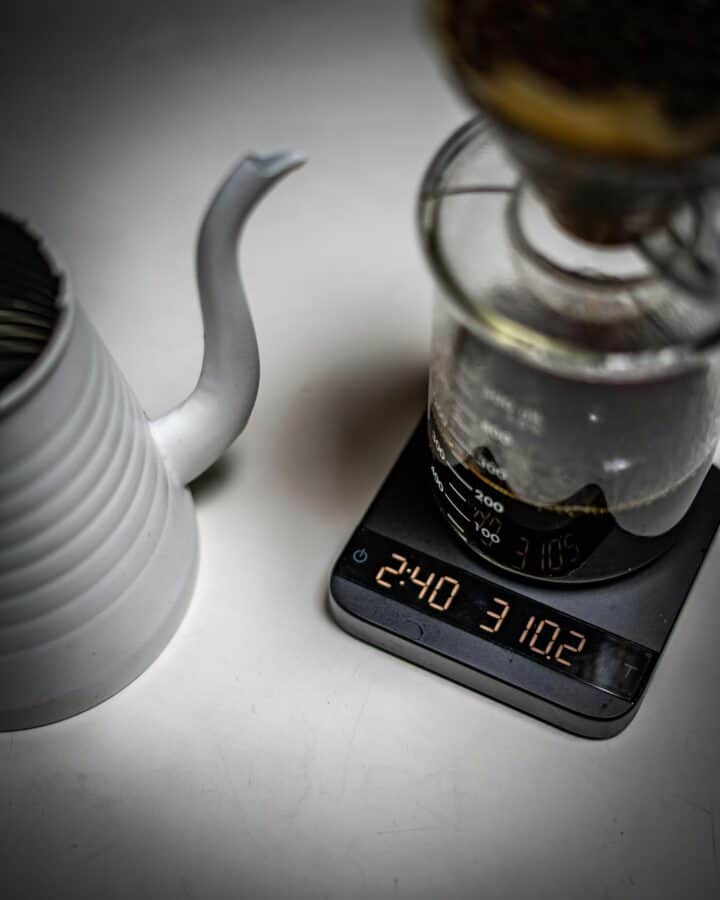 The reason this is more difficult with the V60 compared to other methods of brewing coffee, is that there is a lot of human intervention involved. You have to add the ground coffee to the V60, pour the hot water over yourself and agitate the slurry in the right way, all of which brings human error into the equation!
To make things easier, here’s a step-by-step guide to harnessing the full potential of your V60.
The reason this is more difficult with the V60 compared to other methods of brewing coffee, is that there is a lot of human intervention involved. You have to add the ground coffee to the V60, pour the hot water over yourself and agitate the slurry in the right way, all of which brings human error into the equation!
To make things easier, here’s a step-by-step guide to harnessing the full potential of your V60.
- Grind your coffee to a medium grind size
- Place your paper filter in your V60 and wet it with warm or hot water
- Add your coffee and make a small divot in the middle
- Pour over a small amount of water, allowing the coffee to bloom (50 g)
- Give it a stir and a swirl to evenly distribute the coffee and water
- Pour over the remainder of your water over the coffee grounds (100g at a time)
- Give your V60 a swirl, let all the water drain and enjoy your freshly brewed cup of coffee!
What is a V60 Filter Paper?
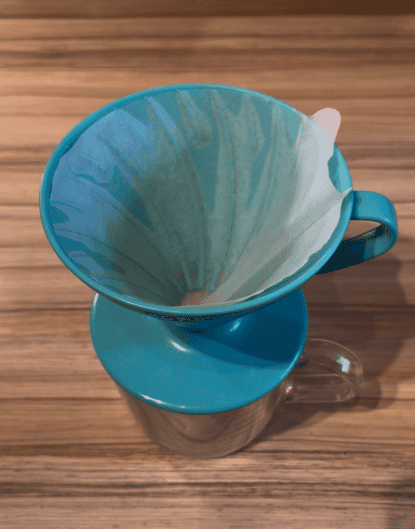 Coffee filter papers are simply the filtration device used to separate ground coffee from the liquid that ends up in your cup. They are often made from paper rather than metallic mesh to strain out as much fine sediment and silt as possible, giving you a clean, smooth and light cup of coffee.
Filter papers are loved by coffee enthusiasts as they remove virtually all of the sediment from the bed of ground coffee, due to the very fine, densely packed holes within them. This allows plenty of delicious, smooth coffee to flow through, without allowing any unwanted silt into your cup.
This smooth, clean tasting cup of coffee is different from the more raw, intense and vicious end product that you might get from a metallic filter, such as those used in an espresso machine or french press. The holes are much wider in a metallic filter, allowing much more fine sediment to enter your cup.
Coffee filter papers are used in drip brew coffee devices, which use gravity and pouring technique to extract coffee oils into your cup. This is in contrast to immersion brewing (French Press, Cold Brew and AeroPress) or pressure based brewing (Espresso and Moka Pot) which use more drawn out and intense coffee extraction methods respectively.
Whether you use a bleached (white) or unbleached (brown) coffee filter paper is up to you. There is an argument that unbleached coffee filter papers offer a more ‘papery’ taste, but if either of these coffee filter papers are wetted before use, pretty much any residual taste will fade away
Coffee filter papers are simply the filtration device used to separate ground coffee from the liquid that ends up in your cup. They are often made from paper rather than metallic mesh to strain out as much fine sediment and silt as possible, giving you a clean, smooth and light cup of coffee.
Filter papers are loved by coffee enthusiasts as they remove virtually all of the sediment from the bed of ground coffee, due to the very fine, densely packed holes within them. This allows plenty of delicious, smooth coffee to flow through, without allowing any unwanted silt into your cup.
This smooth, clean tasting cup of coffee is different from the more raw, intense and vicious end product that you might get from a metallic filter, such as those used in an espresso machine or french press. The holes are much wider in a metallic filter, allowing much more fine sediment to enter your cup.
Coffee filter papers are used in drip brew coffee devices, which use gravity and pouring technique to extract coffee oils into your cup. This is in contrast to immersion brewing (French Press, Cold Brew and AeroPress) or pressure based brewing (Espresso and Moka Pot) which use more drawn out and intense coffee extraction methods respectively.
Whether you use a bleached (white) or unbleached (brown) coffee filter paper is up to you. There is an argument that unbleached coffee filter papers offer a more ‘papery’ taste, but if either of these coffee filter papers are wetted before use, pretty much any residual taste will fade away
Different V60 Types
The V60’s versatility extends beyond its design. It comes in a range of materials, sizes, and configurations. From the classic plastic dripper to the sleek metal and ceramic variants, each type of V60 offers unique characteristics that cater to diverse preferences and brewing styles.Classic Plastic V60
The most popular version of the V60 is the clear plastic brewer. Not only is it the easiest and cheapest to make, but it is also very straightforward to clean and maintain. Whilst there are a few other iterations of the V60 coffee brewer, the clear plastic version is the most commonly used.Hario Drip Decanter
Hario also produces an all in one drip brewer with a built in decanter. This compact and convenient design combines the classic V60 filter with a sleek carafe for collecting your freshly brewed coffee.Glass V60
Hario also offers a classy and sophisticated glass version of the V60. Whilst it is not as robust or practical as the hard wearing plastic version, it is an elegant collector’s item that coffee lovers enjoy.Metal V60
For a more robust and unique design, the metallic V60 by Hario might be for you. It is a great heat conductor so will deliver exceptional brews.Ceramic V60
The classy ceramic V60 is another great coffee collector’s item that will sit proudly on your kitchen counter.V60 Top Tips
Here are a few top tips to help you get the most out of your V60 coffee brewing experience.- Use freshly roasted, high-quality coffee beans for optimal flavour.
- Experiment with grind size, water temperature, and pour technique to refine your brewing process.
- Maintain a consistent pour rate to ensure uniform extraction and balanced flavour.
- Keep your brewing equipment clean and free from residues to preserve the purity of your coffee.
- Don’t skip the blooming phase. Pouring all of your hot water onto your ground coffee at once will ensure you get an uneven coffee extraction, and a bitter or sour tasting brew.
V60 Alternatives
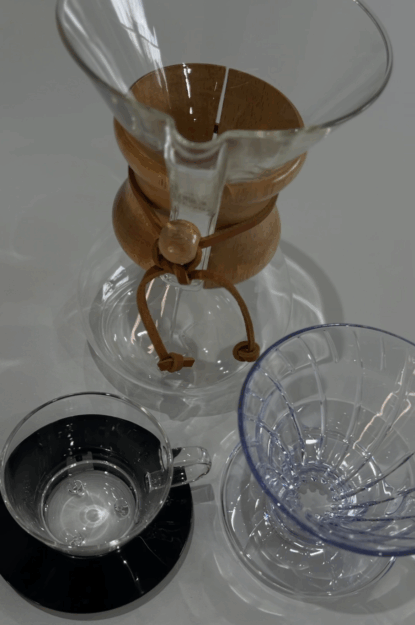 While the V60 shares similarities with other pour-over methods, such as the Chemex and Kalita Wave. Its distinctive cone shape and large single opening offer unparalleled control over extraction and flow rate. This control allows for the customization of brewing parameters, resulting in a cleaner, more nuanced cup compared to other methods like French press or drip machines.
While the V60 shares similarities with other pour-over methods, such as the Chemex and Kalita Wave. Its distinctive cone shape and large single opening offer unparalleled control over extraction and flow rate. This control allows for the customization of brewing parameters, resulting in a cleaner, more nuanced cup compared to other methods like French press or drip machines.
Chemex
The Chemex is a larger and more tricky brewing device than the V60. whilst it is more artistic and elegant, it is also harder to nail the technique. The Chemex als requires a slightly longer brew time and coarse ground coffee due to the larger volume of coffee brewed and thicker filter papers.One Cup/Single Serve Coffee Filters
Single serve filters offer a convenient way to brew great tasting coffee in no time. Whilst the coffee is not freshly ground, it is an easy way to get a better tasting cup of coffee than your standard instant brew. However, the V60 offers much more control variety and ultimately a more delicious cup of coffee as a resultKalita
The Kalita is a flat bottomed coffee brewer that is also cone shaped like the V60. However, due to the increased contact time between the coffee grounds and water at the bottom of the Kalita, there is more opportunity for agitation. The end result is a more full bodied cup of coffee from the Kalita than the V60.Summary
Overall, the V60 is a simple looking coffee brewing device that seems straightforward to use, but requires a bit of love and attention to get right. When you nail the perfect pour, the results are well worth the effort. I hope this ultimate guide to V60 coffee has proved to be the perfect one stop shop to all things pour over brewing. Despite its humble appearance, the V60 can produce some of the most delicious, well balanced and finely tuned coffee on the planet. Picking the right coffee beans for your V60, honing in the perfect grind size and developing your pour over techniques are all great ways to step your V60 game up to the next level. V60 coffee is delicious and well balanced when done right, and it is a very rewarding way to get the most out of freshly roasted and ground coffee beans.V60 Frequently Asked Questions
A medium-fine grind resembling coarse sand is ideal for V60 brewing, allowing for optimal extraction without over-extraction.
A general guideline is to use a ratio of 1:16 (coffee to water) for a balanced cup of coffee, adjusting to taste preferences accordingly.
You can make your V60 coffee stronger by upping the dose of coffee used, reducing the amount of hot water you pour over, and using a slightly darker roasted coffee.
V60’s may look easy to use, but they actually require a solid technique to get the best out of them. Try to pour your water in a circular motion starting from the centre, to ensure that all of your coffee grounds get even coverage.
Yes, using the finely ground coffee for espresso in a V60 is not a good idea. Not only will you end up with bitter, over extracted and sediment filled coffee, but you can also clog up your V60’s filter basket and cause a coffee explosion!
Wetting your V60 filter paper has a range of benefits, including removing the papery taste, improving coffee extraction, increasing water flow rate and heating up your coffee brewing equipment.
Filter coffee and espresso are fundamentally different due to their extraction methods, brew time, filtration system and manual vs automatic nature.
Espresso uses highly pressurised steam, forced through a metal filter basket to drive out rich, velvety, strong coffee shots in around 30 seconds.
On the other hand, filter coffee uses paper filters, a cone shaped brewing device, gravity and pour technique to extract coffee into a mellow, balanced and fresh cup of coffee.

